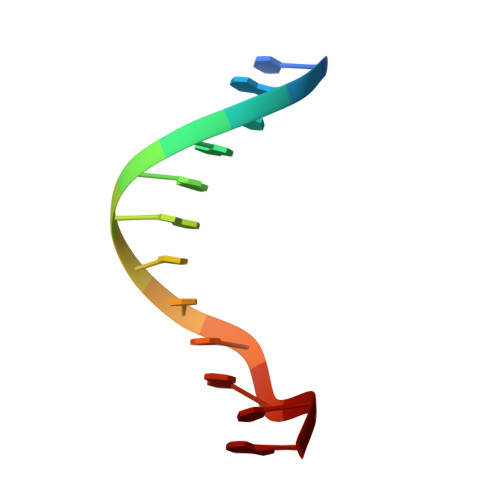Re-refinement of the B-dodecamer d(CGCGAATTCGCG) with a comparative analysis of the solvent in it and in the Z-hexamer d(5BrCG5BrCG5BrCG).
Westhof, E.(1987) J Biomol Struct Dyn 5: 581-600
- PubMed: 3271485
- DOI: https://doi.org/10.1080/07391102.1987.10506414
- Primary Citation of Related Structures:
9BNA - PubMed Abstract:
The effects of X-ray refinement algorithm on parameters characterising nucleic acid structure are analysed following the re-refinement of the B-dodecamer d(CGCGAATTCGCG). The main conclusions are the following. Mean deviations of main chain torsion angles between the two refinements average 12.6 degrees. Phase angle of pseudorotation for sugar puckers vary between 100 degrees and 180 degrees in the present refinement with amplitude of pucker around 30 degrees. On the other hand, the helical parameters have mean deviations less than 2 degrees. At most half of the assigned solvent positions are within 2 A in both refinements. In the second part of the work, plots of temperature factors (B's) versus occupancies (Q's) for solvent peaks have been analysed in the B-dodecamer and in the Z-hexamer d(5BrCG5BrCG5BrCG). Owing to the poor statistics, some of those conclusions should be regarded as tentative. Occupancy appears to depend on the number of contacts made by the solvent peak with the nucleic acid while temperature factor does not. Except when engaged in particular interaction sites, solvent molecules bound to phosphates have a tendency for high B's and variable Q's. Water molecules bound to polar atoms of the bases occupy various positions in the B-Q diagram. Particularly striking is the behavior of the water molecules belonging to the B-spine and to the Z-spine: the spread in occupancy of water molecules in the hydration spine of the Z-oligomer is larger than in the hydration spine of the B-oligomer. An opposite tendency is observed for the temperature factors. The first observation might reflect the special mobility of the water molecules building up the spine hydration in the Z-form where it continues without interruption from one hexamer to the next. In the B-form, on the contrary, the spine is restricted to the center part of the dodecamer. The second observation might reflect the sharpness of the local attractive potential in the Z-form and its broadness in the B-form. In both cases, dipole reorientations would occur, leading to a high local dielectric constant: in the Z-form, through water molecules hopping from one site to another and, in the B-form, because of rotational freedom.
- Laboratoire de Cristallographie Biologique, Centre National de la Recherche Scientifique, Strasbourg, France.
Organizational Affiliation:
















